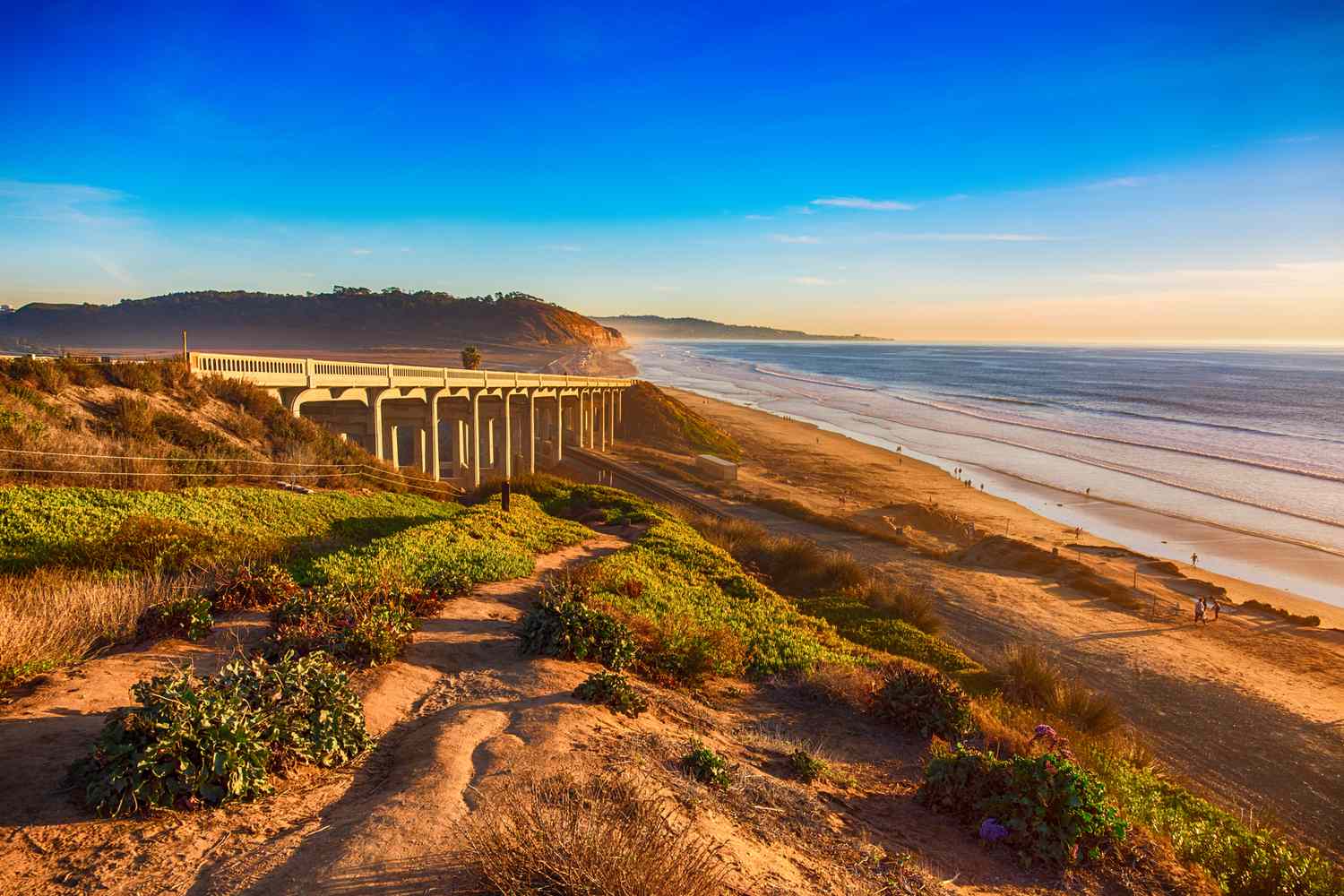:max_bytes(150000):strip_icc():format(jpeg)/TAL-san-diego-lead-image-ELCAMINOREAL0725-088302d1e1cd4a2bab28ef7880126dde.jpg)
- El Camino Real, aka the “Royal Road,” links 21 historic missions up and down the coast of California
- Along the route, travelers can visit wineries, national and state parks, picturesque beaches, and iconic landmarks.
- There are bustling cities like Los Angeles as well as charming small towns like San Luis Obispo along the route.
Between San Diego’s sandy beaches and Sonoma’s wineries, a route winds hundreds of miles up the California coast. You might know it as Interstate 5 or Highway 101, but centuries ago, it had a much more regal name: El Camino Real.
“The Royal Road” dates back to the early days of Spanish rule in California, and construction first began in 1769. For much of its history, the road wasn’t fixed to a single route, and often changed and shifted with weather patterns and even the tides. However, it did have one goal: to connect the 21 missions that dotted the California coast.
Traveling El Camino Real affords a one-of-a-kind glimpse into the state’s past. “The California Missions Trail links so much of our history together,” says David Bolton, executive director of the California Missions Foundation. “It’s become this path of history and beauty, giving you a full understanding of how our society has evolved and become what it is today.”
El Camino Real is also now known as the California Missions Trailbut the highway, still one of the most important in the state, offers so much more than just a history lesson. A drive along El Camino Real takes travelers past panoramic ocean views, fields of colorful wildflowers, and sprawling vineyards. While you’re driving along, you’ll notice the historic bell markers (added in 1906) that mark every mile of the highway.
“The California Missions Trail is just one facet of our state’s rich history, and one of the original road trips travelers can experience today,” says Visit California president and CEO Caroline Beteta. “The influence each mission has on its destination is evident, from the architecture to street names, and even the produce grown in the area.”
Here’s what you need to know before a road trip on California’s El Camino Real.
Places to Visit
Zack Frank/Adobe Stock
Visit the California Missions.
Considering how much the missions define El Camino Real, you should visit at least one on your journey.
“Depending on if you do the whole trail or a portion, you’ll find great examples of missions still serving today as active parishes,” says Bolton. Though you can drive the Mission Trail in either direction, consider starting in the south at San Diego de Alcaláthe oldest mission in California, and ending your trip in Sonoma at San Francisco Solanothe last Spanish mission built in the state. Between the two, there are plenty of other gems to explore, such as Mission San Juan Capistranoknown for its lush gardens and annual Swallows Day Parade, and Mission San Carlos Borroméo de Carmelo (aka Mission Carmel).
The missions have a complex legacy, to say the least, particularly among California’s Indigenous communities. During your road trip, you can also make time to learn about the missions’ complicated history. “It’s vital to acknowledge the Indigenous people who have been in California since time immemorial,” Beteta says. “On your California Missions Trail trip, consider experiences that engage with the Native communities that have offerings for visitors, from museums to nature experiences.”
Have a sip at world-famous wineries.
Oenophiles, you’re in luck—El Camino Real travels through several California American Viticultural Areas, including the Temecula Valleythe Central Coastand, of course, Napa Valley. There are, quite literally, hundreds of options. And when you sample a chardonnay or zinfandel on El Camino Real, you’re participating in a centuries-old tradition.
“The California wine regions came out of the introduction of the wine grape in California by the missionaries,” says Bolton. “It really adds to the experience to visit a winery.”
Hike in a state or national park.
El Camino Real passes through some seriously stunning scenery. When you’re ready to get out of the car and stretch your legs, take a short detour off the main route to explore a variety of both state and national parks. You can hike among the giants at Big Basin Redwoods State Park or, just east of El Camino Real, spot endangered California condors in Pinnacles National Park. If you allot extra time in your trip, you could also hop on a ferry to rugged Channel Islands National Parklocated off the coast of Ventura, California.
Tour historic homes,
The missions are far from the only historic structures of note along El Camino Real. You may want to make a quick side trip to San Simeon’s Hearst Castlebuilt by 20th-century media pioneer William Randolph Hearst and open daily for tours. Up north in San Jose, California, you can visit the Winchester Mystery Housean opulent but quirky mansion with 160 rooms, doors that lead to nowhere, and a touching ghost story to boot. And while it’s not quite a mansion, the ruins of Jack London’s Wolf House in Sonoma County will attract any literary buff interested in learning more about the “Call of the Wild” author’s riveting life.
Enjoy the sun and sand.
Much of El Camino Real runs parallel to California’s coastlineand some of the state’s finest beaches are just a short drive off the main route. “The mission system was set up by Spaniards coming on land and also by sea,” says Bolton. “California is known for its beautiful coastline, so there are portions where you can enjoy the ocean as well.”
Soak up the year-round California sunshine on the purple sand beaches of Big Sur at Julia Pfeiffer Burns State Park or at the famed surf breaks of La Jollaa neighborhood of San Diego. Be sure to make time to stop by picturesque lighthouses in locations like Pigeon Point (one of the tallest lighthouses in the U.S.) and Old Point Lomawhich have gorgeous historic buildings and sweeping Pacific views.
How to Plan a Trip
You can traverse the entire length of El Camino Real today, but at 600 miles in length, you may want to split the journey up into sections.
Depending on what you want to see and how long you want to stay at each of your destinations, you can spend two to three hours driving per day, allowing plenty of time for both planned activities and spur-of-the-moment stops. El Camino Real follows Interstate 5 and Highway 101 most of the way up the coast, though short jaunts off the freeway will be required to see some of the missions and other attractions. Along the way, keep an eye out for El Camino Real’s distinctive roadside bells, added in the early 1900s to mark the route.
When to Go
Chelsea Loren/Travel + Leisure
Since California’s coastal climate is temperate all year long, there’s never really a bad time to travel El Camino Real. But there are a few seasonal elements to keep in mind as you plan your trip. “Spring and fall are really the best times,” says Bolton. “If you go in the fall, you’re able to enjoy the wine harvest that you’ll find in many of the popular wine regions in the state.”
During spring, meanwhile, you might glimpse brilliant orange fields of California poppies and other wildflowers along El Camino Real. As for winter and summer, expect the occasional rainstorm during January and February, and more crowds and warm days during the hottest months of the year. Temperatures get especially toasty at destinations located more than half an hour inland from the shore.
Where to Stay, Eat, and Drink
Bill Perry/Adobe Stock
Carlsbad
The seaside town of Carlsbad is around 35 miles north of the start of El Camino Real in San Diego. Though you won’t find any missions in Carlsbad, you will find an impressive selection of hotels (such as the Four Seasons Residence Club San Diego or the Park Hyatt Aviara Resort) and Michelin-starred eateries such as Young and pretty and Consumption. Beyond its beaches, Carlsbad is best known for its colorful flower fields, which come into bloom for a few months every spring.
Santa Barbara
Known as the American Riviera for its mild climate and popularity among the rich and famous, the seaside city of Santa Barbara needs no introduction. For a luxe experience, you could rest your head at San Ysidro Ranch (voted one of the best resorts in the U.S. by readers in T+L’s World’s Best Awards 2025) and visit award-winning restaurants like Silvers Omakase. If you stop here, you’ll be a relatively short drive away from the San Buenaventura and Santa Inés missions and, of course, Mission Santa Barbarathe headquarters of the California Missions Foundation.
San Luis Bishop
Home to the Mission San Luis Bishop of Toulousethis Central Coast town is known for its laid-back vibes, its massive weekly farmers market, and the quirkiest hotel in America, the Madonna Inn (don’t skip the pink champagne cake). Vineyards like Tolosa Winery, Chamisal vineyards, Biddle Ranch are within striking distance, as are eateries such as Nate’s on Marsh and Tognazzini’s Dockside Restaurant in neighboring Morro Bay.
Carmel-by-the-Sea
Though small, this town just north of Big Sur has it all: award-winning restaurants, luxury stays (Villa Mara made T+L’s WBA list in 2025), and a cute-as-a-button fairytale atmosphere. Near Mission San Carlosyou’ll find Carmel Mission Trail Nature Preserve, a perfect place to stretch your learned in some well-earned peace and quiet. “Forest bathing beneath the Monterey pines and coast live oaks is a serene experience like no other,” says Beteta.
Petaluma
Petaluma is just 25 minutes west of Mission San Francisco Solano in Sonoma, California, and the end of El Camino Real. It provides quintessential wine country ambiance with fewer crowds than its more famous neighbors, Sonoma and Napa. Though Sonoma County has countless attractions of its own—wineries, gastronomic restaurants, and stunning redwood groves, to name just a few—staying in Petaluma also puts you near all that San Francisco has to offer as well.





